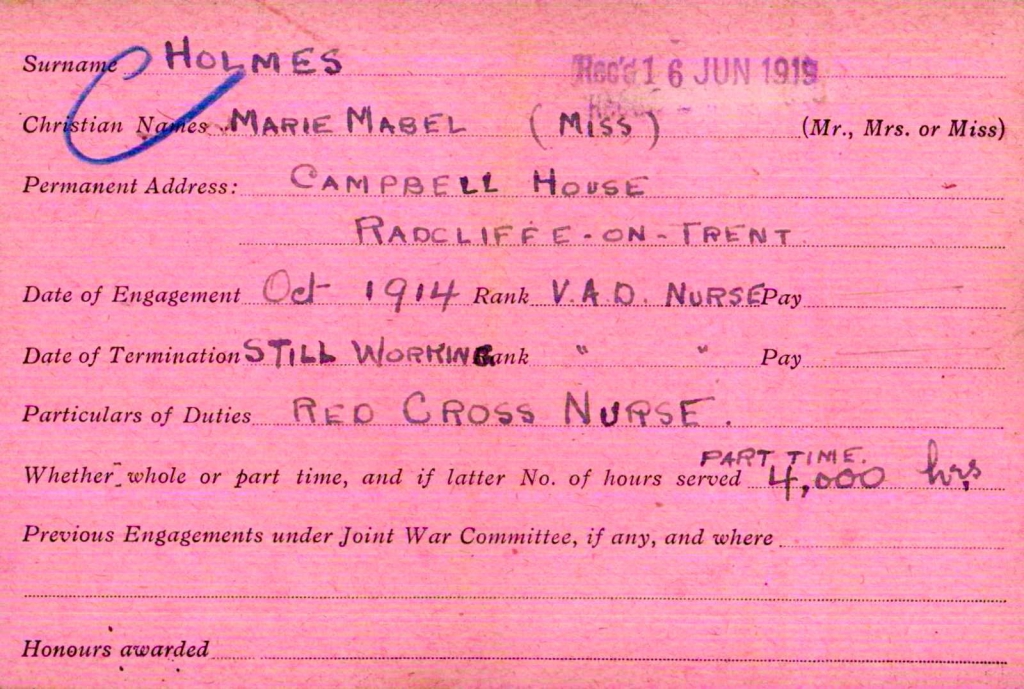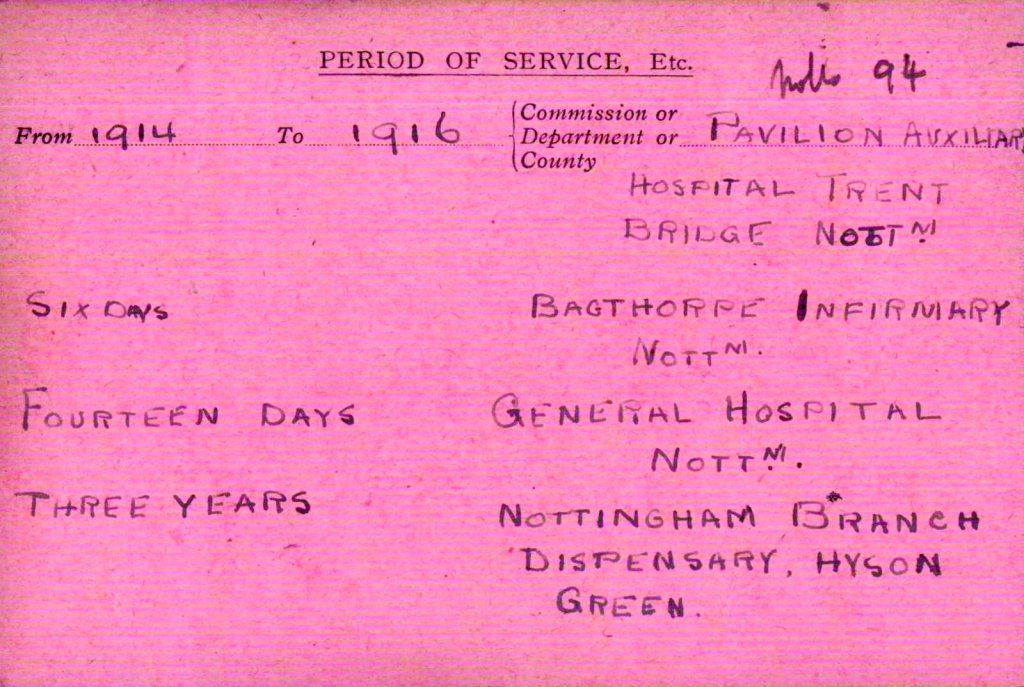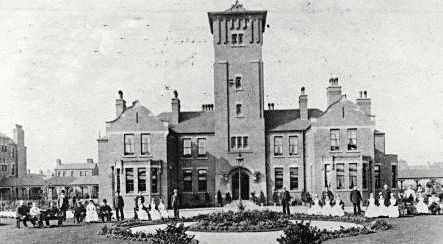MARIE MABEL HOLMES 1882–1974
Born: 15th June 1882 in Nottingham
Marriage: Marie remained single
Died: 1974, Nottingham district
Before the First World War
Marie was living at Campbell House, Shelford Road, Radcliffe on Trent in 1911, with her father George, a lace manufacturer, mother Harriett, brother Francis and two domestic servants.
During the War
The following information about Marie Holmes has been extracted from transcribed Red Cross V.A.D. records, available at www.redcross.org.uk .
Marie was in the 94th Voluntary Aid Detachment, the Radcliffe on Trent branch of the Red Cross which was organised by Claire Birkin. When Marie was engaged as a Red Cross V.A.D. in October 1914 she was thirty-two and single. She was still living at Campbell House, Radcliffe. Her brother Francis served in the war as an officer; he was a captain in the 1st South Nottinghamshire Hussars.
Marie started work as a V.A.D. nurse at the Pavilion Auxiliary Hospital Trent Bridge Nottingham, working there from 1914 to 1916. In 1914 the Committee and membership of the Nottinghamshire Cricket Club made the Pavilion at the cricket ground available for use as a hospital for wounded servicemen.
The Cricket Club annual report for 1917 includes the following:
‘The Hospital at the Pavilion has now 100 beds. 1,074 Patients were admitted during 1917, making the number of patients treated since the opening of the Hospital 2,309. The West Bridgford Masonic Electrical and Mechanical Wards, established through the generosity of the Freemasons of Nottinghamshire, to which has been added the ‘Monty Hind’ Ward, erected and equipped by Mr. J. W. Hind, makes this probably the most efficient and best equipped hospital in the country.’
The Pavilion continued as a hospital until March 1919, by which time more than 3,500 patients had been treated.
After serving at the Pavilion Hospital, Marie spent six days at Bagthorpe Infirmary Nottingham. At the start of the war the former Bagthorpe Workhouse and Infirmary became a military hospital. By the end of the war 750 patients were accommodated there. From Bagthorpe Infirmary Marie moved to Nottingham General Hospital, where she worked for two weeks.
After serving at the General Hospital Marie spent three years at the Nottingham Branch Dispensary, Gregory Boulevard, Hyson Green, Nottingham. In World War 1 dispensaries performed services similar to those provided by hospitals. Some offered a more limited range such as dispensing medicines, dressings and offering check-ups etc, whereas others were more like hospitals. The Branch Dispensary at Hyson Green was in the latter category. It was a branch of the Nottingham General Dispensary, which was based on Broad Street, Nottingham. In 1916 the Branch treated 300 home patients, 2024 outpatients, including 547 accidents and emergencies, and 411 dental patients. There were 2448 visits by surgeons to the Branch. By 1917, numbers of home and outpatients had risen to 422 and 2146 respectively, including 615 accidents and emergencies. Visits by surgeons had increased to 3414, but dental cases had fallen to 343. No figures are available for 1918.
In all, Marie had worked a total of 4,000 hours part time when her details were entered on her Red Cross record card and she was still working as a V.A.D. nurse.
1921 Census
Address: Campbell House, Shelford Road, Radcliffe
Employment: home
Household: father George, Lace Mfg., mother Harriett, maid Annie Hopewell, servant Dorothy Thornton
After the war
Marie remained unmarried. We do not know whether she continued in a nursing career after the war. She is listed on the 1931 electoral register as still living with her mother Harriett Eugenie at Campbell House, Shelford Road, Radcliffe on Trent. In 1939 she was living with her incapacitated mother Harriett at 69 Priory Road, West Bridgford. She was not in paid employment. She died at the age of ninety-two in Nottingham district.
Red Cross V.A.D.Registration Card for Marie Holmes
Excerpt from Notes on Nottingham Hospitals www. nottinghamhospitalshistory.co.uk
Upon the outbreak of war, 102 beds were immediately placed at the disposal of the military authorities. The Jubilee Wing of Nottingham General Hospital was soon full of sick and wounded soldiers and further hospital expansion became necessary. In 1915 temporary wards to accommodate 150 casualties were built on the front lawn. The complement of beds at the Cedars was increased to 50 for less serious cases. Broxtowe House, which still serves the hospital as a home for resident medical staff, was bought for £547. The Thornton family house in the Ropewalk was given to the hospital and the Red Cross provided additional equipment and nurses. Another temporary building for a further 53 beds was erected in 1917 – with the War Office and Mr W.G. Player sharing the cost. The huts were soon in use, heated by six large stoves provided by Mr W.G. Player who afterwards added a balcony to accommodate twenty more patients. Despite the great influx of war casualties, the number of civilian patients remained at the pre-war level of 219. The various ambulance corps did fine work in transporting patients to and from the hospital. As well as terrible wounds, the sick and injured soldiers were suffering from trench fever, nephritis, neuritis and shellshock. During the war, the hospital developed one new method of treatment (physiotherapy) but refused to provide outpatients facilities for venereal disease; these were developed by the Local Authority on Glasshouse Street.
Hospital trains arrived constantly in Nottingham, most of the wounded being sent to the military wing of Nottingham General Hospital, and the Bagthorpe Hospital (Nottingham City Hospital), though several of the smaller hospitals such as the Trent Bridge V.A.D. Hospital, the Berridge Road Hospital and the Albert Hall Hospital were also used.
Bagthorpe Military Hospital, Nottingham
Author: Pauline Woodhouse



